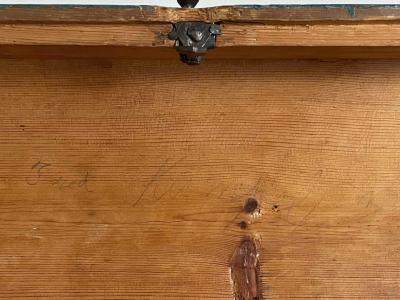Trunk
Northern Europe, probably Sweden
c. 1790
Measurements
18-1/8 in x 30 in x 21 in
Materials
Unidentified European conifer, iron fittings
Credit Line
Historic Odessa Foundation, gift of H. Rodney Sharp
Accession Number
1959.3791
Inscription
“Sofia Lindberg / Middletown / Del.” is painted onto the outside top of the trunk. “Fred Kumpel Mch 30 70 90” is written in pencil on the underside of the lid.
Provenance
Ex coll. H. Rodney Sharp
Comments
This domed and canted trunk or chest exhibits the rare circumstance of having a name and place written on the outside, as well as another name and probable date on the inside. The names, Sofia Lindberg and Fred Kumpel, are likely Swedish. Sofia's name on the outside suggests the destination for this trunk--an inscription readily visible to anyone who might handle it. Despite all of this evidence, reliable identification of the crate remains uncertain.
Design, materials, and construction of the trunk indicate that its origin lies outside of the United States. The Swedish names suggest a likely place of origin. The canted design alone is not sufficient evidence, but combined with the iron fittings and other features, it points away from America. The wood from which the trunk is made appears to be a resinous pine with many knots and similar blemishes. The size of the boards is also smaller than usually found in America. Trunk sides are made of pieces of pine glued edge-to-edge. The lock is an inexpensive spring or grab or crab lock of the Germanic (Northern Europe) type and not one seen in American work. It is nailed to the inside of the chest with a diamond escutcheon of iron screwed in on the front of the keyhole.
Most persuasive of non-American origin is construction. The side boards are butted at the corners. Thin iron strapping with decorative sawtooth cutting on both sides (not observed in American objects) folds over the chest corners and along the domed edges of the top. Nails driven into each tooth and clinched on the inside (i.e., hammered flat against the wood so that they cannot come out) hold the chest together. Two additional iron straps, also nailed, run around the chest and lid inside the sawtooth strapped edges. Thus, without the iron strapping, this trunk would fall apart. The chest stands on four small 5/8-inch-tall square blocks that are nailed inside the angled corner straps.
A flat-head screw serves as a knob for the lid. No evidence of an earlier knob exists. Iron carrying handles are nailed into each side; the nails are clinched. Inside, the trunk has a till without a lid on the left side; its construction is flimsy. This entire object does not embody the level of longterm durability evident in almost all other early wooden furniture and furnishings.
The Lindberg and Kumpel names have not yet been identified. The dating of this trunk assumes that the numbers following Kumpel's name are a date. If so, the use of cut nails and a lock of that design reinforce a 1790 date rather than 1890 (or 1690).


